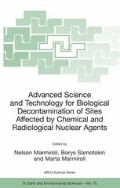Abstract
Plants are among the most tolerant of organisms to pollution, which emphasises their utility for the emerging science of environmental biotechnology. Many botanical families, in particular the Brassicaceae, Poaceae, Fabaceae, Asteraceae, Salicaceae, Chenopodiaceae, and Careophylaceae include multiple species showing phytoremediation potential, and other families (Cyperaceae, Amaranthaceae, Cannabaceae, Cannaceae, Typhaceae and Pontederiaceae) contain promising individual species: Each species enjoys certain advantages, but suffers some limitations for application as phytoremediants. Careful selection of the appropriate family and genotype to match the particular pollutant and environment is crucial for successful phytoremediation.
Access this chapter
Tax calculation will be finalised at checkout
Purchases are for personal use only
Preview
Unable to display preview. Download preview PDF.
References
Anderson C. W. N., Brooks R. R., Stewart R. B., and Simcock R., 1998, Harvesting a crop of gold in plants, Nature 395:553–554.
Bakker M. I., Vorehout M., Sum D. T. H. M., and Kolloffel C., 1999, Dry deposition of atmospheric polycyclic aromatic hydrocarbons in three Plantago species. Environ. Toxicol. Chem. 10:289–2294.
Brooks R. R., 1998, Plants that hyperaccumulate heavy metals, CAB International, University Press, Cambridge.
Chaney R. L., Angle J. S., Wang A. S., McIntosh M.S., Broadhurst L., and Reeves R. D., 2005, Phytoextraction of soil Cd, Ni and Zn using hyperaccumulator plants to alleviate risks of metal contaminated soils requiring remediation. International Workshop Current developments in remediation of contaminated lands p. 39, 27–29 October 2005. Pulawy, Poland.
Cobbett C. S., 2000, Phytochelatins and their role in heavy metal detoxification, Plant Physiol. 123:825–832.
Fletcher J. S., and Hegde R. S., 1995, Release of phenols by perennial plant roots and their potential importance in bioremediation. Chemosphere 31:3009–3016.
Goldsbrough P., 2000, Metal tolerance in plants: The role of phytochelatins and metallothioneins, in: Phytoremediation of contaminated soil and water, N. Terry, G. Banuelos, eds, Lewis Publishers, Boca Raton.
Harms H., Bokern M., Kolb M., and Bock C., 2003, Transformation of organic contaminants by different plant system, in: Phytoremediation; Transformation and control of contaminants, S. C. McCutcheon, J. L. Schnoor, eds., John Wiley & Sons, Inc., Hoboken, New Jersey.
Hermanson M. H., and Hites R. A., 1990, Polychlorinated biphenyls in tree bark, Environ. Sci. Technol. 24:666–671.
Ma Q. L., Komar K. M., Tu C., Zhang W., Cai Y., and Kennelley E. D., 2001, A fern that hyperaccumulates arsenic, Nature 409:579.
Newman A. L., Strand S. E., Choe N., Duffy J., Ekuan G., Ruszaj M., Shurtleff B. B., Wilmoth J., Heilman P., and Gordon M. P., 1997, Uptake and biotransformation of trichloroethylene by hybrid poplar, Environ. Sci. Technol. 31:1062–1067.
Morikawa H., Higaki A., Nohno M., Takahashi M., Kamada M., Nakata M., Toyohara G., Okamura Y., Matsui K., Kitani S., Fujita K., Irifune K., and Goshima N., 1999, More than a 600-fold variation in nitrogen dioxide assimilation among 217 plant taxa, Plant Cell Environ. 21:180–190.
Orcutt D. M., and Nilsen E.T., 2000, The physiology of plants under stress, John Wiley & Sons Inc., New York.
Piechalak A., Tomaszewska B., Baralkiewicz D., and Malecka A., 2002, Accumulation and detoxification of lead ions in legumes. Phytochemistry 60:153–162.
Pulford I. D., Riddel-Black D., and Stewart C., 2002, Heavy metal uptake by willow clones from sewage sludge-treated soil: The potential for phytoremediation. Int. J. Phytorem. 4:59–72.
Rauser W. E., 1995, Phytochelatins and related peptides, Plant Physiol. 109:1141–1149.
Sell J., Kayser A., Schulin R., and Brunner I., 2005, Contribution of ectomicorrhizal fungi to cadium uptake of poplar and willows from a havey polluted soil, Plant Soil 277:245–253.
Staci L. S., and Hites R. A., 1994, Importance of vegetation in removing polycyclic aromatic hydrocarbons from the atmosphere, Nature 370:49–51.
White P. M., Wolf D. C., Thoma G. J., and Reynolds C. M., 2006, Phytoremediation of alkylated polycyclic aromatic hydrocarbons in a crude oil-contaminated soil, Water Air Soil Pollut. 160:207–220.
Winska-Krysiak M., and Gawronski S. W., 2002, Fizjologiczne aspekty tolerancji i hiperakumulacji ołowiu w wybranych genotypach Brassica. [Physiological aspects of lead tolerance and hyperaccumulationin Brassica species]. Zeszyty Problemowe Postepów Nauk Rolniczych 481:605–613.
Wolverton B. C., 1997, How to grow fresh air: 50 house plants that purify your home or office, Penguin. 144 p. New York, USA.
Author information
Authors and Affiliations
Editor information
Editors and Affiliations
Rights and permissions
Copyright information
© 2007 Springer
About this paper
Cite this paper
GAWRONSKI, S.W., GAWRONSKA, H. (2007). PLANT TAXONOMY FOR PHYTOREMEDIATION. In: Marmiroli, N., Samotokin, B., Marmiroli, M. (eds) Advanced Science and Technology for Biological Decontamination of Sites Affected by Chemical and Radiological Nuclear Agents. NATO Science Series: IV: Earth and Environmental Sciences, vol 75. Springer, Dordrecht. https://doi.org/10.1007/978-1-4020-5520-1_5
Download citation
DOI: https://doi.org/10.1007/978-1-4020-5520-1_5
Publisher Name: Springer, Dordrecht
Print ISBN: 978-1-4020-5518-8
Online ISBN: 978-1-4020-5520-1
eBook Packages: Earth and Environmental ScienceEarth and Environmental Science (R0)

